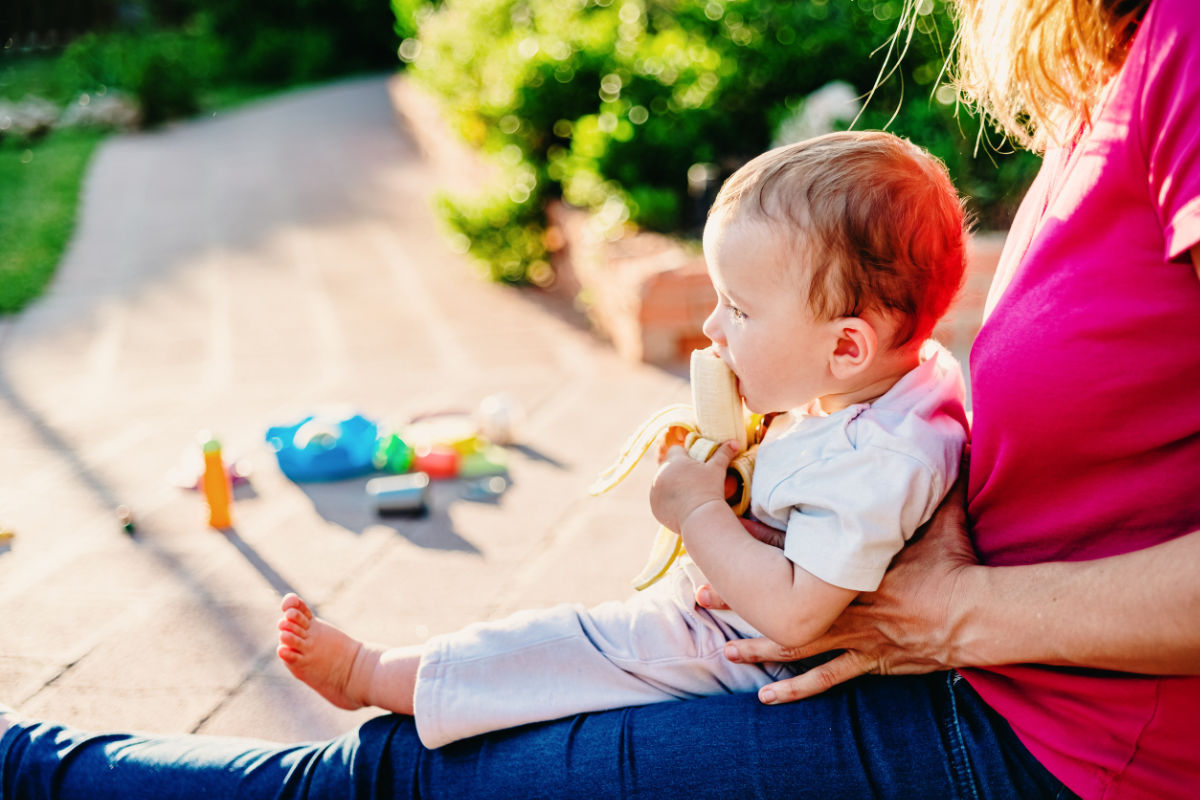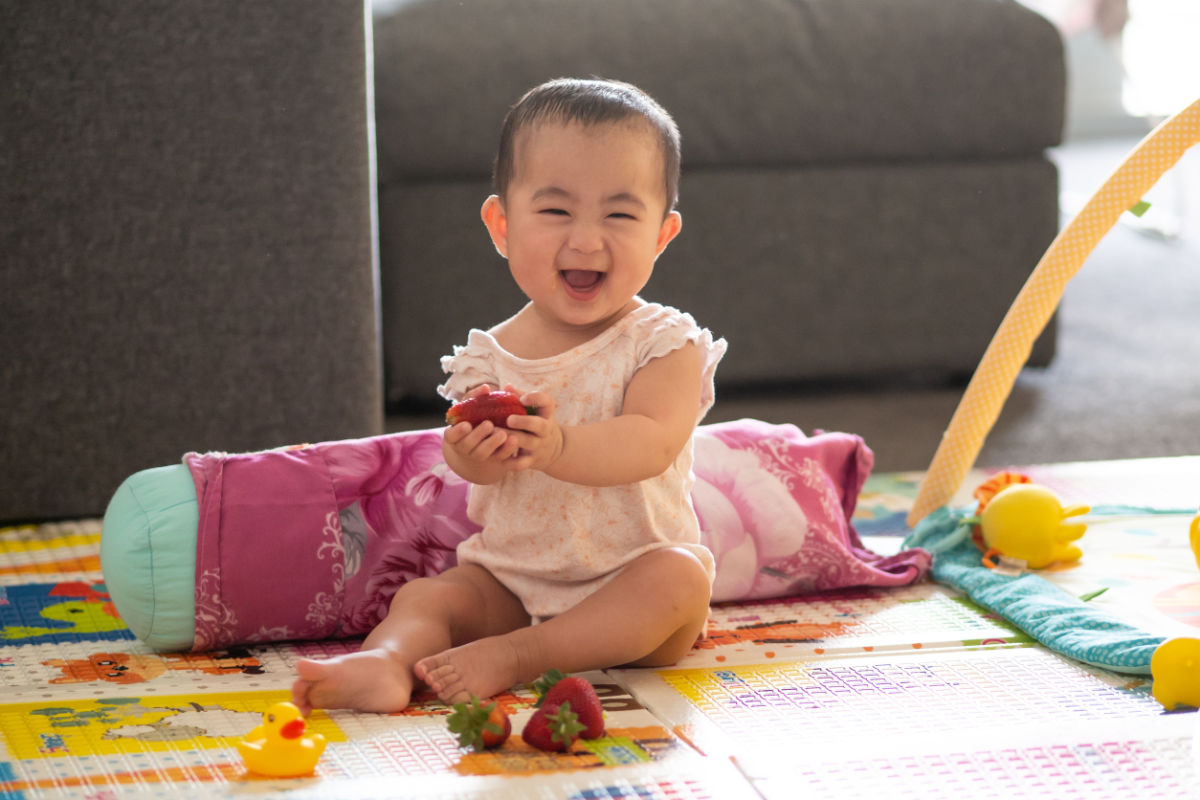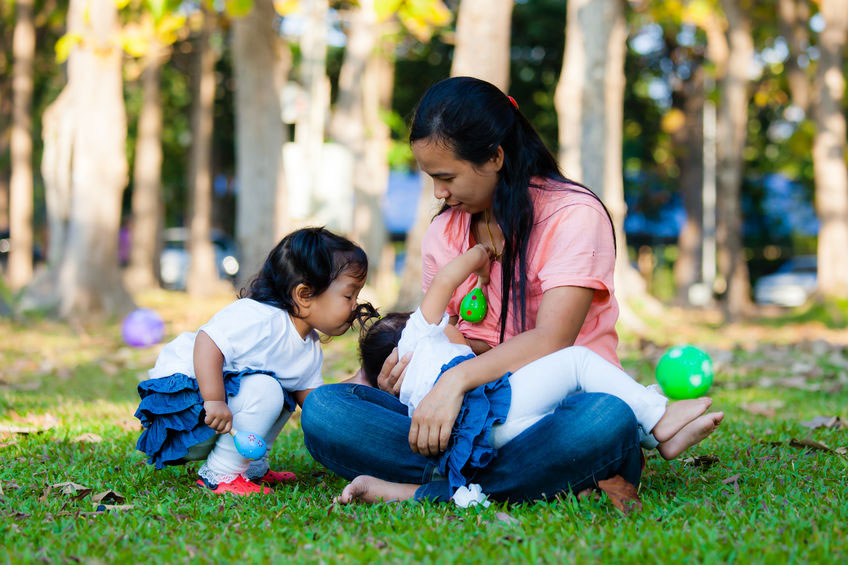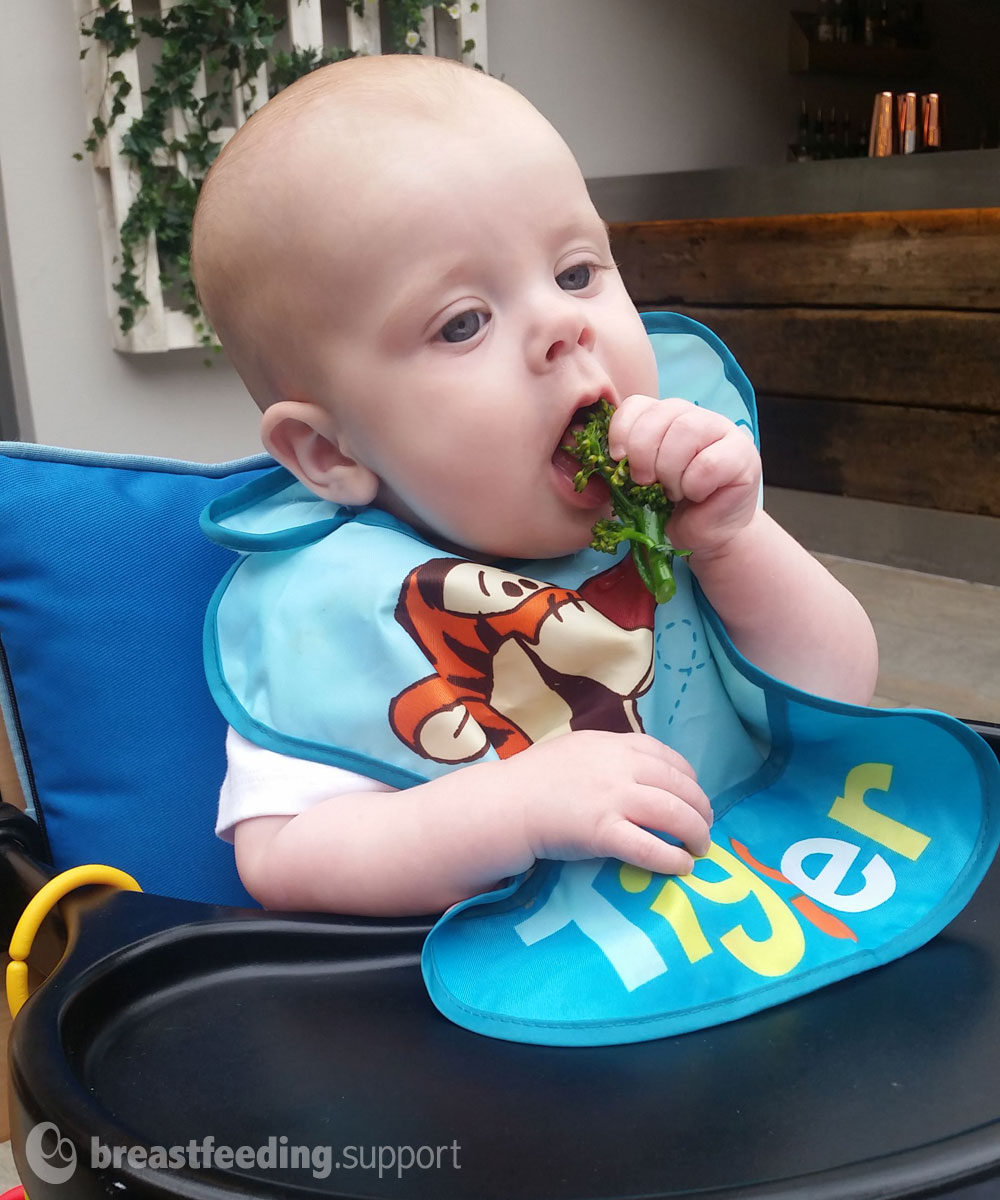Breast milk is all your baby needs for many months. It is a complete food, full of health benefits and it protects against illness. Although exciting to introduce a baby to solid food, hurrying them to the next stage too soon is linked with an increased risk of infections, poor growth or developing obesity. This article shares the recommendations around starting solid foods with a breastfed baby and answers frequently asked questions.
When will my baby be ready for starting solid foods?
Most authorities around the world recommend that breastfed babies only have breast milk until around six months of age—e.g. UNICEF, World Health Organisation (WHO), National Health Service UK (NHS) , American Academy of Paediatrics (AAP). By this age a baby’s digestive system, kidneys and immune system are better developed to cope with introducing complementary foods alongside breast milk.

Signs of being ready for solids
Between five and seven months of age a baby will begin to show behavioural and developmental signs that he is ready to start solid food. These include a baby being able to sit up on his own, being able to pick up food between his thumb and forefinger and losing the tongue thrust reflex—a protective tongue reflex that pushes food back out of the mouth in young babies. However, La Leche League’s book The Art of Breastfeeding explains—your baby is ready once he can reach for food himself and put it in his own mouth:
Normally, the baby’s insides are ready [for solid food] once her outside has developed enough to eat them on her own. If she can’t pick up food, get it in her mouth, and swallow it without gagging, she’s probably not ready for solids, and her tummy probably isn’t, either.
Baby-led weaning
At one time babies were traditionally weaned onto food that had been pureed into a smooth semi solid texture that could be spoon fed at a young age. With this technique the parent does the feeding and the baby doesn’t have much control over what is going into their mouth. However, by waiting for the developmental signs of readiness above, parents can follow their baby’s lead when introducing solid food by letting them feed themselves. This is sometimes known as baby-led weaning.
Advantages of baby-led weaning include:
- Baby can control what they eat and go at their own pace cutting down on meal-time struggles
- Avoids overfeeding with high water content solids at the expense of nutrient rich breast milk
- More enjoyable for baby, gives more independence and encourages a healthier relationship with food
- Baby has a better self awareness of when they are full helping to prevent obesity
- When done appropriately, there is no greater risk of gagging on solid food with baby-led weaning.12
A useful book discussing the baby-led weaning approach in much more detail is Baby-Led Weaning The Essential Guide (2019) by Gill Rapley and Tracey Murkett.

Keep breastfeeding on demand
Most babies will not swallow very much food at first, and breastfeeding on demand continues to be the main source of nutrition during the first year of life, with solids gradually adding to the total calorie intake. For this reason, starting solids is often referred to as complementary feeding or the complementary feeding period (WHO 2021; UNICEF 2018). Breast milk continues to be both a nutritious food and to support a child’s immune system regardless of how old the baby is.3456
Offer nutritious food
If complementary feeding is started too soon or isn’t done appropriately a baby may have faltering growth (WHO, 2021). For example letting a baby fill up on too many low calorie foods in place of breast milk could result in a baby getting less total nutrition than before solids were introduced. Carlos Gonzalez, a Spanish paediatrician and author, highlights the lower calorific value of some food compared to mothers’ milk in the following excerpt:
Mothers’ milk has 70kcal (kilocalories, commonly known as calories) per 100g (3.5oz). By contrast boiled rice has 126kcal, cooked chickpeas (garbanzos) 150kcal, chicken 186kcal, bananas 91kcal per 100g (3.5oz)—but apples have only 52kcal, oranges 45kcal, cooked carrots 27kcal, cooked cabbage 15kcal, cooked spinach 20kcal, green beans 15kcal and lettuce 17kcal per 100g (3.5oz). And this is providing that these foods have been drained well; if the water they have been cooked in is included, they are even less substantial.
Ensuring that breastfeeding is not restricted while offering a range of healthy foods alongside will keep a baby well fed and allow them to gradually reduce their breast milk intake according to their individual readiness.7
Breast milk volumes six to twelve months
A general guide to the volume of breast milk needed per day while babies are exclusively breastfeeding in the first six months is often cited as 750-1035ml per day (25-35oz).8 As baby takes more solid food towards the end of the first year, this volume will gradually decrease. Baby-led weaning authors Rapley and Murkett explain that between six and nine months the amount of breast milk a baby drinks should stay about the same while the amount of solid food gradually increases. From about nine months most babies begin to reduce their milk feeds as solids become a more substantial part of their diet (Rapley and Murkett. 2019. p 55). For an idea of daily volumes of alternative milks needed for formula fed babies during weaning see Infant Milks: A Simple Guide to Infant Formula, Follow-On Formula and Other Infant Milks p16.
Breast milk beyond 12 months
Breastfeeding author and lactation consultant Nancy Mohrbacher indicates that breastfed babies between one and two years old may still get 35-40% of their energy needs from breast milk and she cites studies that showed older nurslings (15 months and 30 months respectively) might have up to 300ml breast milk per day (Mohrbacher, 2020. p 74 & 149). The exact amount of breast milk in the diet will vary according to cultural differences and individual babies.
What if my baby doesn’t seem interested in food?
The Art of Breastfeeding explains why some babies are slower than others to begin enjoying complementary food and why parents don’t need to worry:
Your milk can keep him going for quite a while longer, providing a nice, wide comfort zone. It’s a complete blend of nutrition, vitamins, minerals, electrolytes and fluids, not to mention anti-infective, anti-inflammatory, and immune system-boosting factors. Your “late-starter” or “long-term dabbler” isn’t missing any developments or milestones. He may still need to develop his chew-and-swallow skills. He just needs a few more days, weeks, or months.
Even before they eat solid food, breastfed babies are beginning to sample the flavours of their mother’s diet via breast milk:
Traces of a mother’s diet pass into breast milk and the milk is said to adopt the flavour of the food that the mother has eaten. This allows a breastfed baby to gradually become accustomed to family table foods and may help baby to accept a wide range of familiar tastes when solids are started.
First foods
With a few exceptions, by the time he can reach out for them at around six months, your baby can begin to sample the same healthy table foods as the family. The following resources discuss nutritious first foods, examples of finger foods to try, foods that present a choking risk and should be avoided, and many other tips for introducing solid food.
- Your Baby’s First Solid Foods. NHS. 3 October 2022
- Foods to Avoid Giving Babies and Young Children. NHS. 18 August 2022
- Baby-Led Weaning The Essential Guide (2019) by Gill Rapley and Tracey Murkett.
First drinks
A breastfed baby may not need anything other than breast milk to drink during the first year as long as he can nurse whenever he wants to. However if a baby shows an interest, he can practice drinking a little tap water from an open cup or a free-flow cup without a valve with his meals.9
Cows’ milk to drink?
Cows’ milk has a number of disadvantages as a drink. Cows’ milk is very filling and can take the place of more nutritious foods in the diet, it can also increase the risk of a baby being anaemic or having an allergic reaction including constipation.1011 The UK’s First Steps Nutrition Trust (2019) advise waiting until twelve months of age before considering giving whole cows’ milk as a drink. For much more information about cows’ milk and other alternative milks see:
- Infant Milks: A Simple Guide to Infant Formula, Follow-On Formula and Other Infant Milks (2019) by First Steps Nutrition Trust
- Is it Safe to Use Cow’s Milk or Other Milks as a Supplement to Breastfeeding? by Kelly Bonyata 2023.
Cows’ milk can be used in cooking as a food rather than a drink from around six months of age.12
Starting solid foods when baby has allergies
Robyn Noble, lactation consultant and author of Breastfeeding Works! Even With Allergies explains that not all babies are ready for solids at six months especially babies who have already had a negative reaction to their mother’s diet via breast milk. These babies often can’t handle solids well until around nine to twelve months old. Some babies cope with solids even later than this and they will need to be closely monitored to ensure they are still getting all the nutrients they need from breast milk. Noble suggests stewed pear, sweet potato, stewed apple, pumpkin, avocado and courgette (zucchini) as suitable first foods for an allergic baby. 13
Introducing potentially allergenic foods
Introducing solid foods while continuing to breastfeed is thought to help protect a baby against developing food allergies and coeliac disease.14 The UK’s National Health Service (NHS) article linked below lists foods that can potentially trigger an allergic reaction such as cows’ milk, eggs, gluten, nuts and peanuts, soya, fish, celery and more. They recommend:
When you start introducing solid foods to your baby from around 6 months old, introduce the foods that can trigger allergic reactions one at a time and in very small amounts so that you can spot any reaction.
If your baby already has an allergy, such as a diagnosed food allergy or eczema, or if you have a family history of food allergies, eczema, asthma or hay fever, you may need to be particularly careful when introducing foods. Talk to your GP or health visitor first.
Current advice for peanut and egg (UK)
A 2018 document from the Scientific Advisory Committee on Nutrition (SACN) and the Committee on Toxicity of Chemicals in Food, Consumer Products and the Environment (COT)15 considered all the available research regarding the best time to introduce peanut and hen’s egg into a baby’s diet. This included two studies1617 that looked at introducing potential allergens in a baby’s diet before six months of age. SACN-COT concluded there was not enough evidence to recommend introducing peanut or hen’s egg to an infant’s diet before six months of age. The joint SACN-COT statement recommends:
- Breastfeed exclusively for six months
- Continue breastfeeding while complementary foods are added in an age appropriate form**
- Introduce peanut and hen’s egg alongside breastfeeding between 6-12 months of age
- Once introduced and tolerated, continue to include peanut and egg in the diet on a regular basis
- If a baby is at high risk of allergy, parents can seek medical advice before introducing allergenic food.
- Deliberately excluding peanut or hen’s egg beyond six to twelve months of age may increase the risk of allergy to these foods.
**Refer to the full document’s warning against giving infants whole nuts (a choking hazard) and raw egg (associated with food poisoning).
Current advice (USA)
In the United States, information from the American Academy of Pediatrics (AAP) differs from UK advice. The AAP state that babies who are at high risk of allergy to peanut can be introduced to suitable baby friendly peanut products from four to six months of age—after allergy testing and under medical supervision.18
What are the symptoms of allergy?
General symptoms of allergy are discussed in more detail in Milk Allergy in Babies. Author Robyn Noble explains that if a baby is intolerant to something when starting solids, parents may notice eczema appearing or worsening, baby may start getting colds and other infections, baby may start fussing or crying more, become more unsettled at night and there may be new breastfeeding behaviour such as wriggling, fussing or biting. Noble explains that allergenic proteins in weaning diets can cause stronger reactions than when encountered via breast milk because the mother’s body will have broken them down into smaller molecules before passing into the milk. Likely problem weaning foods include cows’ milk products such as milk, infant formula, custard and yoghurt (Noble, 2015).
Biting behaviour and allergy?
If breastfeeding problems such as wriggling, fussing and biting at the breast begin soon after starting solids, they may be associated with food allergy and corresponding discomfort. Robyn Noble describes a phenomenon she calls Hypertonic Bite Response to describe how a baby may breastfeed abnormally when they are in pain and very tense. See Baby Biting While Breastfeeding for a summary of ideas to help with this specific cause of biting and The Fussy Breastfed Baby explores other reasons for a baby to be unhappy or restless when breastfeeding.
Frequently asked questions
Will starting solid foods help my baby sleep through the night?
There doesn’t appear to be a link between starting solids and sleeping longer at night. It’s quite developmentally normal to wake at night. If allergenic proteins in a weaning diet affect a baby negatively however, infant sleep may be disrupted (Noble, 2015). For more information about night-waking see Baby Waking Up at Night.
My four-month-old/five-month-old seems hungry, should I start solids?
If your baby seems to be feeding more often, waking more often at night, chewing their fists or is easily distracted during feeds, you may wonder whether they are hungry and ready to start solid food. Although this may sometimes be the case, particularly if their weight gain is slow, there can be other explanations for these behaviours apart from hunger. It may help to contact a breastfeeding specialist to help you work out what is happening. If your baby does need more calories but you are struggling to increase your milk supply you may wonder whether to start supplementing with formula or whether to start solids early. This can be discussed with your health visitor or baby’s doctor. Canadian paediatrician Jack Newman says;
most pediatric societies around the world recommend exclusive breastfeeding to six months (but that does not mean exactly 182½ days). Mothers with late-onset decreased milk supply are often told they cannot give solids at five months but must give formula instead if the baby is not gaining well. But in these cases, the baby needs extra calories. If he gets formula, he won’t be exclusively breastfeeding anyway. And giving a bottle will often be the final blow to breastfeeding. If we let the baby eat as much high quality food as he wants, he will get the nutrients and calories he needs to gain more weight, and will still get the nutrients, calories and protection from illness from his mother’s milk.
And Dr Newman goes on to give some guidance on types of suitable high calorie foods (p.113):
babies at this age can eat banana, avocado, mashed potato, ground beef and chicken, the latter two being much better sources of iron than commercial cereals or formula for that matter.
For further information see our articles on increasing milk supply, reasons for a baby to wake more at night, biting at the breast and explanations for fussy or unhappy behaviour.

What if there is undigested food in my baby’s nappy?
Opinions seem to vary whether undigested food in the nappy is quite normal even into the second year of life (Dr Jack Newman’s Guide to Breastfeeding p. 286) or whether it is a sign that your baby isn’t ready for solids. Author Linda Palmer says:
For babies in the first days of starting solid foods, however, if food comes out looking the way it went in, it’s a good sign that baby’s digestive system is just not ready. Although it’s likely not particularly harmful, it seems more appropriate to just wait some weeks before trying again. Food that doesn’t digest can cause some tissue irritation and floral disturbance, and it’s clearly not providing any nutrition.
Does breast milk have enough iron?
The iron content in breast milk complements a baby’s iron stores until they begin solid food at around six months of age and can begin to get additional iron from their wider diet. For a full discussion on this topic see Iron in Breast Milk.
Does breast milk have enough vitamin D?
The levels of vitamin D in breast milk depend on a mother’s vitamin D levels. Because many people are deficient in vitamin D due to modern lifestyles, vitamin D supplements are generally recommended for both mothers and babies. For more information see Vitamin D and Breastfeeding.
When does breast milk stop being beneficial?
Some people are under the impression that breast milk has no nutritional value after a fixed length of time e.g. six months or 12 months may be mentioned. However, breast milk continues to be beneficial and nutritious from the first drop to the last (see references above).

Summary
Breast milk is a complete food for around the first six months. At about this age babies will start to reach for food off your plate, signalling they are ready to begin solids. Breast milk will continue to be their main source of nourishment during most of the first year.
*Book extracts reproduced by permission from Pinter & Martin.